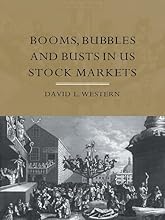Booms, bubbles, and busts in US stock markets by David Western
In the US stock market things have changed a great deal since the heady days of the 1980s and we are now entering an era of profound uncertainty, with most analysts predicting trouble ahead. Indeed, the alarming decline of the NASDAQ shows no sign of abating and the fear is that traditional industries will be the next to bite the dust. September 11th has only added to the gloomy mood.
A user-friendly overview of the inner workings of the US stock market, this book examines the current market conditions before looking back to the events of the past century - the Great Depression, the 1970s oil crisis, the party-for-the-rich atmosphere of the 1980s and the emergence of the new economy.
|
Table of contents :
Book Cover......Page 1
Half-Title......Page 2
Title......Page 3
Copyright......Page 4
Contents......Page 5
Figures......Page 12
Tables......Page 14
Foreword......Page 15
Acknowledgements......Page 18
From one bubble to another?......Page 20
A unique set of circumstances?......Page 21
How absurd were valuations?......Page 22
Why did Greenspan ignore ‘irrational exuberance?......Page 23
Greenspan and the markets......Page 25
The Fed’s enemy: inflation or deflation?......Page 26
What are the lessons from the 1929 bubble?......Page 27
Japan’s mess and deflation: what can the United States learn?......Page 28
The massive policy push: powerful enough to create sustainable growth?......Page 29
A bull or bear market rally?......Page 31
Introduction......Page 33
Origins of the bubble......Page 34
Stocks versus bonds......Page 36
Absurd valuations......Page 39
The bubble: geopolitical forces at work?......Page 41
The bubble: underwritten by a stable bond market?......Page 43
Debt, savings and switching......Page 44
Warning signals: why not switch?......Page 46
What of corporate earnings?......Page 47
Similarities with 1929......Page 49
Where from here?......Page 50
Conclusion......Page 51
Introduction......Page 53
Macroeconomic background......Page 54
The policy paradigm......Page 58
Dip and recovery: 1990–1......Page 60
The policy-induced correction: 1994–5......Page 62
Up, up and away: 1996–7......Page 66
Correction and a major recovery: 1998–2000......Page 71
A real bubble?......Page 72
Financial perspectives......Page 74
Conclusion......Page 75
Introduction......Page 76
Portfolio choice......Page 77
Diversification and risk......Page 79
News: economic or financial?......Page 81
Market efficiency......Page 82
Investing over the life cycle......Page 83
The fundamentals approach......Page 84
The contrarian strategy......Page 86
Serial correlation and mean reversion......Page 88
Investment strategies......Page 90
Expectations, trading and timing......Page 92
Conclusion......Page 94
Biases in the one-way street......Page 96
Where were the arbitragers?......Page 103
Old benchmarks and turning points......Page 104
Was it a speculative bubble?......Page 105
The ‘New’ new economy......Page 106
The 1990s: a deviation from fundamentals......Page 107
Wealth storage and far-sightedness......Page 109
Greenspan’s defense of the NASDAQ bubble......Page 110
Domestic origins of the boom......Page 112
Conclusion......Page 113
Introduction......Page 115
Productivity growth and the stock market......Page 116
A rational bubble?......Page 117
Old questions and old answers......Page 118
The productivity slow down debate......Page 119
Sources of productivity growth......Page 120
The IT and communications revolution......Page 122
IT and communications: drivers of productivity growth?......Page 125
US government and productivity growth......Page 126
Productivity growth: how permanent?......Page 127
Productivity and the stock bubble......Page 128
Conclusion......Page 129
Market versus government failure......Page 131
Incentives and trade-offs......Page 134
What are the challenging issues?......Page 136
Wall Street in the 1960s: fresh challenges......Page 137
Past pressure for regulation......Page 138
The case of Enron......Page 140
A dangerous incentive structure?......Page 141
Regulatory reform and the Sarbanes-Oxley Act......Page 142
Conclusion......Page 144
Introduction......Page 146
Ultimate objectives and trade-offs......Page 147
The government environment......Page 148
America’s economic cruise speed: what guideposts?......Page 149
Diagnosis of imbalances......Page 151
Hitting targets: what policy mix?......Page 155
What economic indicators?......Page 156
Critics of the ‘Wrong Paradigm’......Page 158
Canterbery’s Vatican paradigm......Page 159
Reputation and credibility of the Federal Reserve......Page 160
The caterpillar market and fear of the Fed......Page 161
Confessions of a central banker......Page 162
Conclusion......Page 163
Introduction......Page 165
Deregulation of the financial sector......Page 166
Financial product innovation......Page 167
Technology and innovation......Page 169
The effectiveness of monetary policy......Page 172
Target interest rates or monetary aggregates?......Page 174
Does money affect output?......Page 175
Channels of the monetary transmission mechanism......Page 176
Does money affect stock prices?......Page 178
Interest rates: how effective on output?......Page 179
Interest rates: what affect on stocks?......Page 181
Conclusion......Page 182
Introduction......Page 184
Greenspan’s economic philosophy......Page 185
Greenspan and the markets......Page 188
Power to move the economy?......Page 192
Mistakes in the Greenspan era?......Page 193
Greenspan’s two flagships......Page 196
Flexibility: Greenspan’s hallmark......Page 198
Conclusion......Page 200
Seeds of the bust in the 1920s......Page 201
Damage to the real economy......Page 203
Causes of the 1929 crash and depression......Page 204
The Keynesian view......Page 205
The Galbraith-Kindleberger view......Page 206
The monetarist view......Page 208
Financial sector disintermediation and balance sheets......Page 209
Goods price deflation......Page 210
Asset price deflation......Page 211
What lessons have we learnt?......Page 212
Could history repeat itself?......Page 213
Conclusion......Page 214
Japan’s old growth strategy......Page 215
Weaknesses and seeds of destruction......Page 217
Policy levers......Page 218
Why the asset price bubble?......Page 219
Financial not economic constraints......Page 221
Japan’s asset price bubble: liquidity roots?......Page 222
Monetary policy failure......Page 223
Monetary transmission mechanism: clogged pipes?......Page 224
Fiscal policy failure......Page 226
Krugman’s insight......Page 228
Japan’s policy response: why so ineffective?......Page 229
Lessons from Japan’s financial crisis......Page 230
Flow on effects from Krugman’s solution......Page 231
Lessons from Japan’s stagnation......Page 232
Conclusion......Page 233
Some commonalities......Page 234
Financial origins of the bubble......Page 235
The roller-coaster of speculation......Page 237
Crony capitalism and accelerated development......Page 238
Erosion of competitiveness......Page 239
Foreign forces......Page 240
Excess liquidity revisited......Page 241
Why did the bubble burst?......Page 242
The Asian crisis: why so sudden?......Page 244
Stock market performances: post bubble......Page 246
Conclusion......Page 250
Introduction......Page 251
From one bubble to another?......Page 252
What of currency instability?......Page 253
The liberation of Iraq......Page 254
Geopolitical forces......Page 255
Synchronization and integrated markets......Page 256
Why the US stock rally?......Page 258
The powerful policy stimulus......Page 259
The US economic recovery: where from here?......Page 262
Conclusion......Page 263
Bibliography......Page 267
Index......Page 273 |


 扫码加好友,拉您进群
扫码加好友,拉您进群